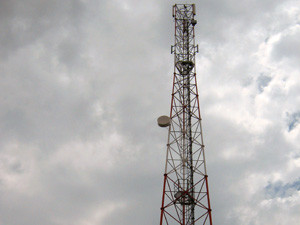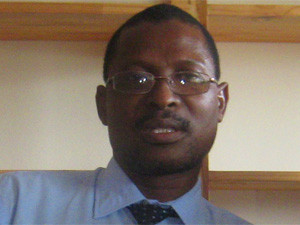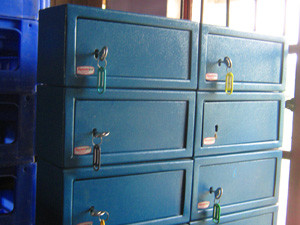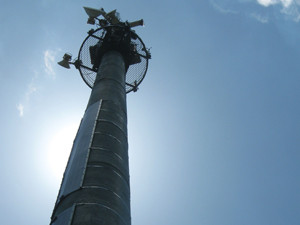
The Mhlupheki high school was built like any other school, complete with doors and windows, chairs, desks and chalkboards. But unlike the average school, this northern KwaZulu-Natal learning centre ran for several years without electricity. While the necessary infrastructure was in place to utilise electricity, there just wasn't any. The lights were fitted, but didn't switch on, and an appliance plugged into the wall socket wouldn't run.
With a Vodacom base station a couple of hundred metres from the school, the company saw an opportunity to help the community through its Community Power initiative. The mobile operator installed solar panels on the school roof, and the electricity produced by this installation now powers both the base station and the school.
"We were so surprised when we came here," says Vodacom's executive head of CSI and sustainability, Suraya Hamdulay. "All the resources were here, they just needed the electricity. We literally just flipped the switch."
According to Thembinkosi Mkhonto, principal of Mhlupheki high school, the solar panel installation at the small community school has changed how the educators teach and how the students learn. "There are no power lines anywhere here," says Mkhonto. "If you do not have a generator, you cannot make it here. Without any electricity, things were very difficult and expensive."

At peak capacity, the panels generate about 40KW hours per day, which is more than enough to meet the needs of the school. The conversion to sustainable energy has saved the school about R15 000 in the year since it was installed.
Electrifying education
During the recent end-of-year exams, there was a spike in electricity use at Mhlupheki, something that Maya Makanjee, chief officer of corporate affairs, says is a positive sign. "This shows us that the children are coming to study, they're using the resources and that is exactly what we wanted to happen." And hopes are that it'll show in the students' results. Mkhonto expects the matric pass rate this year to be as high as 74%, up from 54% last year.
In addition to the solar energy, Vodacom also kitted out the school's computer centre with equipment that Mkhonto says is used during lessons, morning assemblies and for entertainment. Many past pupils from Mhlupheki now teach computer skills at the school, as there is no permanent computer teacher, according to Mkhonto.

In the past, teachers would write exam papers on chalkboards, and they had to travel into the nearest town to photocopy documents. "Life has changed from rural to urban within the school," he says. For Mkhonto, the solar electricity has saved the school time and money, and allows teachers to concentrate more on their work of educating the community.
"Now, the learners like to come to the school, because they can see that this particular school is different," he says, adding that the adult learners who use the facilities at night no longer have to do so by candlelight. "Now these old mamas and fathers can learn how to write and read using the school's facilities. We are so happy that we have moved from zero to hero."
Sharing resources
The school has become a hub for the community, according to Mkhonto. The local primary school just across the road still lacks electricity, but has access to the high school's resources. Even the mobile clinic, which visits the community every two weeks, makes use of the solar power. In the past, community members had to travel into town to print or make photocopies, but now they use the school's facilities. "Anything that the community needs to use the school for, we allow them to do so."

All of the work in Emfihlweni was done with the full support of the local chief, Nkosi Tembe, who Hamdulay says was one of the instigators of the project. "It is very difficult to progress in a remote community," says Tembe. "The people here have not been exposed to any types of technology, so giving them this opportunity is very important."
According to Feroz Koor, head of sustainability at Vodacom, it is vital to understand the unique needs of the people before anyone can make a difference. "There is no single model for this sort of project," Koor says.
In Emfihlweni, access to clean water has always been an issue. Today, the solar energy powers a borehole pump that provides fresh water to the school and community. "A water pump on the school grounds draws water from the borehole using the power generated from the solar panels. This was run by a generator in the past, which is costly, unreliable and bad for the environment," says Koor. Water from the borehole is also connected to a tap outside of the school grounds, which is used extensively by the community, he adds.
"People living in this area used to run into the bush and hide behind branches when they needed to use the toilet, but now life has changed and we appreciate this," says Mkhonto, noting that the lack of clean water meant that students used to drink palm wine and come to school and "cause a lot of chaos", which doesn't happen anymore.
Cellphone charging station
According to Mkhonto, most of the people of Emfihlweni have cellphones, but none have the electricity to charge them. In the past, community members would pay as much as R40 to have someone take their phone into town to be charged. To make this process a little easier, Vodacom partnered with the owner of Emfihlweni's local shop. By fitting an adjacent building with solar panels, the shop owner is able to offer people a phone-charging service at no cost.
Inside the shop, Vodacom has set up various phone-charging stations where people can bring their phones to be charged. Each box has a number on it and a corresponding key, allowing people to leave their phones to charge without any worry. According to Koor, the shop owner charges about 24 phones each day using the sustainable energy, and the charging station has boosted business. "This charging station brings a lot of customers to the shop. This is the only shop in the area and this charging is really doing something good for the community," says Mkhonto.
Base station efficiency
In addition to powering Mhlupheki, the team from Vodacom is working to make the base station more energy efficient by using superior technology. "Improving the efficiency on the actual site means we have a lot more energy available to supply to the school and the community," says Etienne Gerber, an engineer and the manager of the Vodafone Site Solution Innovation Centre, in Midrand. "Everything at this base station is running more efficiently because we have introduced better equipment."
According to Gerber, the new equipment at the Emfihlweni site reduced the power consumption of the base station by about 60%, to just 1KW. The actual base station has been in place for over two years, and with the move to solar power, the team is constantly looking at ways to make the tower run more economically.
With batteries already on the site, Gerber says the team decided to charge up the batteries with any excess energy from the solar panels to supply additional capacity should any problems occur. "Everyone looks at the project expenditure and comments on how much money this sort of thing costs. Yes, we probably could've done it on a smaller scale, but we were thinking about the future needs of the community as well."
For Hamdulay, the Emfihlweni project represents a common understanding between Vodacom and the community. "If the solar power isn't working, the base station won't be working, which is bad for business. This means that this project will always remain relevant to us," says Hamdulay.
Gerber agrees: "One of the greatest challenges for the community is continued support," he says. "Other projects have been implemented in this area in the past, but as soon as something stops working the people just disappear."
"For us, this venture is about longevity - as long as there is a base station in the area, we will have a vested interest in this project and so it's a win-win for us and for the community," Hamdulay concludes.
"This sort of project is about more than technology, it is about the Vodacom team being innovative with the use of our technology. It is both social and technological. We call it social innovation."
Share